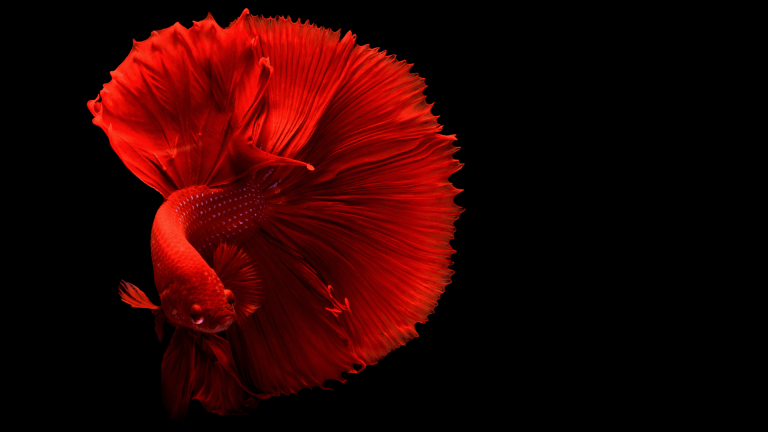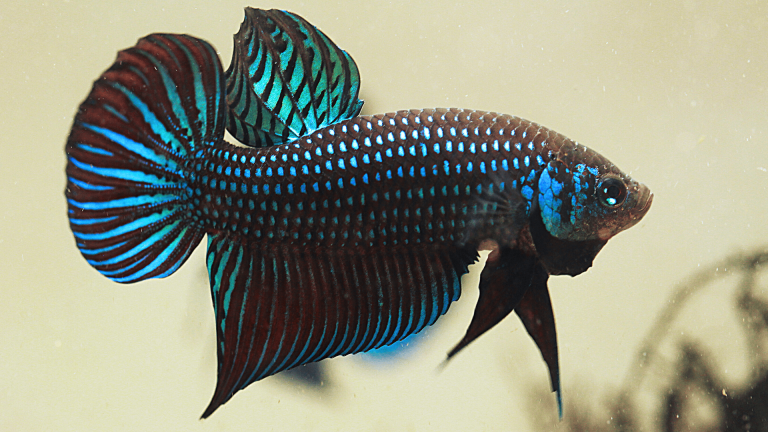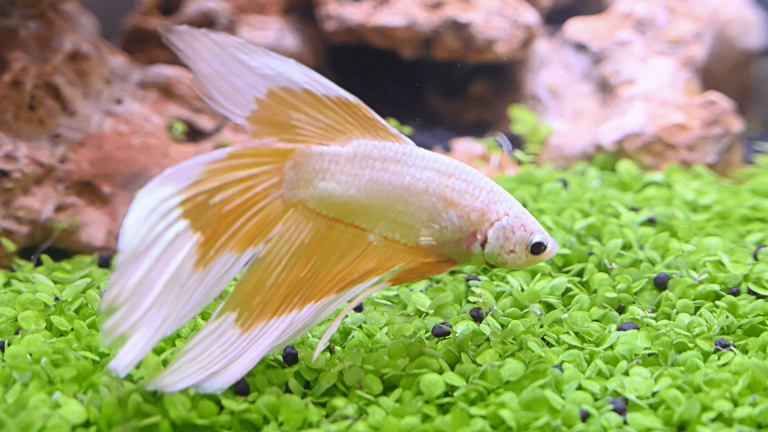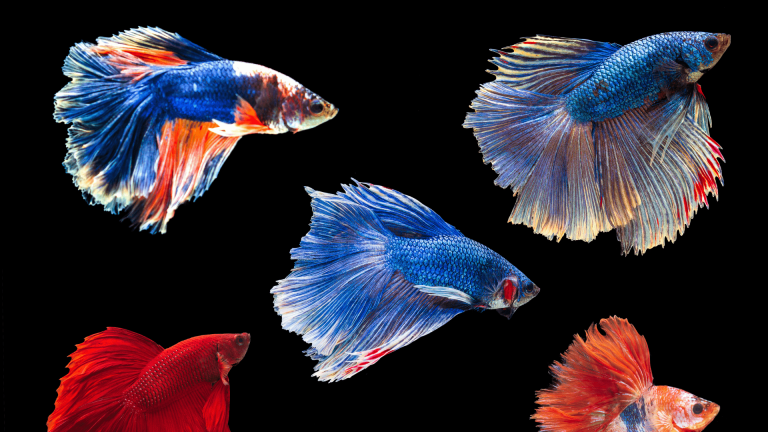Can Betta Fish Live With Goldfish? 6 Varieties of Goldfish
Can Betta Fish Live With Goldfish? Betta fish, also known as Siamese fighting fish, originate from the rice paddies of Southeast Asia. They are admired for their vivid colors and flowing fins, which make them appear elegant and graceful. On the other hand, goldfish have been domesticated for centuries and come in various shapes and colors. They are social creatures that thrive in the company of their own kind. Given their differences, many aquarists wonder if these two species can live together in harmony.
Understanding Betta Fish: Can Betta Fish Live With Goldfish?

History and Origin
Betta fish, scientifically known as Betta splendens, have a fascinating history that dates back centuries. Originally found in the slow-moving waters of Southeast Asia, particularly in Thailand, Cambodia, Vietnam, and Malaysia, bettas have been admired for their beauty and grace for generations.
Historically, bettas were not the colorful and diverse fish we know today. Wild bettas had more subdued colors and shorter fins, which were ideal for surviving in their natural habitat. It wasn’t until selective breeding in the 1800s that their stunning colors and flowing fins were developed.
Physical Characteristics
Betta fish are relatively small, typically growing to about 2-3 inches in length, with males being slightly larger than females. Their elongated bodies are covered in vibrant colors, ranging from brilliant shades of red, blue, green, and purple, to more subdued hues like yellow and white.
One of the most distinctive features of bettas is their long, flowing fins. These delicate and ornate fins make them stand out among other freshwater fish. The fins are used not only for propulsion but also for display during courtship and aggressive encounters.
Behavior and Temperament
Betta fish are known for their complex and diverse behaviors. While they can be charming and engaging, they are also known for their territorial and aggressive nature, especially when it comes to other male bettas. Because of this aggression, male bettas are best kept alone, except during breeding.
In contrast, female bettas can often coexist peacefully in groups called sororities, provided the tank is spacious and has ample hiding spots. However, even in a sorority, there may be occasional scuffles, so close monitoring is essential.
Bettas have an organ called the labyrinth, which allows them to breathe oxygen from the air. This adaptation enables them to survive in oxygen-deprived waters, such as stagnant rice paddies, where they are known to jump to the water’s surface to gulp air.
Getting to Know Goldfish: Can Betta Fish Live With Goldfish?

A Brief History
Goldfish (Carassius auratus) have a rich history that traces back over a thousand years to ancient China. Originally bred from wild carp, goldfish were domesticated for their striking colors and ornamental qualities. The Chinese selectively bred them to enhance specific traits, leading to the development of various goldfish varieties.
During the Song Dynasty (960-1279 AD), goldfish were first kept as ornamental fish in garden ponds and later made their way into indoor aquariums during the Ming Dynasty (1368-1644 AD). Eventually, goldfish breeding spread to Japan and other parts of the world, where enthusiasts continued to refine and expand the diversity of goldfish types.
Varieties of Goldfish
One of the most captivating aspects of goldfish is the wide array of shapes, colors, and sizes they come in. Some popular goldfish varieties include:
Common Goldfish
This is the classic goldfish, characterized by its bright orange color and streamlined body shape.
Comet Goldfish
Comets have a slender body and long, flowing tail fins that resemble a comet’s tail, hence the name.
Fantail Goldfish
Fantails have a double tail and a more rounded body shape, giving them a graceful appearance.
Oranda Goldfish
Orandas are recognized for their unique head growth called a “wen,” which covers the top of their head like a cap.
Ryukin Goldfish
Ryukins have a humpbacked body shape and elegant, flowing fins.
Telescope Goldfish
Telescopes have protruding eyes that resemble a telescope, making them a unique and endearing variety.
These are just a few examples of the many goldfish varieties available, each with its distinct beauty and charm.
Behavior and Social Structure
Goldfish are known for their friendly and social nature. They thrive in groups and are best kept with other goldfish or non-aggressive tank mates. When kept in a group, they exhibit fascinating interactions, such as swimming together, exploring their environment, and foraging for food.
Although goldfish are generally peaceful, they can be competitive during feeding times. It’s essential to ensure that all fish have access to food by providing multiple feeding spots and monitoring their behavior during mealtime.
Additionally, goldfish are opportunistic eaters and may nibble on plants, so selecting hardy aquatic plants or providing other forms of enrichment can help keep them entertained and reduce the chances of excessive plant destruction.
The Challenges of Keeping Betta Fish and Goldfish Together

While the idea of housing betta fish and goldfish together may seem enticing, several challenges must be addressed to ensure the well-being of both species. Here are some of the main obstacles faced when attempting to keep them in the same tank:
Different Water Requirements
One of the primary challenges stems from the distinct water requirements of betta fish and goldfish. Betta fish are native to tropical regions and prefer warmer water with stable temperatures, typically ranging from 78-80°F (25-27°C). On the other hand, goldfish are cold-water fish and thrive in temperatures between 65-72°F (18-22°C).
Maintaining a suitable water temperature that accommodates both species can be tricky. Keeping the water too warm for goldfish can stress and even harm them, while cooler temperatures can make betta fish lethargic and susceptible to diseases.
Aggression and Territory Issues
Betta fish, particularly males, are well-known for their territorial and aggressive nature. They have a reputation as “Siamese fighting fish” for a reason. When housed with other fish, especially those with long, flowing fins like goldfish, bettas may perceive them as rivals and exhibit aggressive behaviors such as fin-nipping and chasing.
Even if the initial interactions seem peaceful, bettas can suddenly become aggressive, leading to potential injuries or even fatalities. This aggression is not limited to goldfish; bettas may also display hostility towards other tank mates.
Size and Space Constraints
Goldfish can grow significantly larger than betta fish, and this size difference can lead to accidents or stress in a shared tank. The larger, more active movements of goldfish can unintentionally injure the smaller and more delicate bettas.
Moreover, both bettas and goldfish have specific space requirements to thrive. Bettas need space to swim freely near the water’s surface due to their labyrinth organ, while goldfish require ample space to explore and forage at the tank’s bottom. A cramped environment can lead to stress, poor health, and territorial disputes.
Potential Compatibility Solutions
Although keeping betta fish and goldfish together requires careful consideration, it is not an impossible task. With proper planning and a few key solutions, it is possible to create a harmonious community tank that accommodates both species. Here are some potential compatibility solutions:
Large Community Tanks
The key to successfully housing betta fish and goldfish together lies in providing a spacious tank. A larger tank helps reduce aggression and provides ample swimming space for all inhabitants. A tank size of at least 30 gallons is recommended to accommodate both species comfortably.
In a larger tank, bettas and goldfish can establish their territories without feeling overly confined, reducing the likelihood of territorial disputes.
Adding Hiding Spots
Creating hiding spots within the aquarium is crucial for both bettas and goldfish. Adding live or artificial plants, rocks, and decorations allows bettas to retreat and feel secure when they need a break from social interactions or if they feel threatened.
Hiding spots also serve as visual barriers, preventing continuous direct contact between bettas and goldfish, which can lead to aggressive behaviors.
Monitoring Tank Dynamics
Regular observation of the tank’s dynamics is essential when housing different fish species together. Keep an eye on the behavior of both bettas and goldfish, especially during the initial introduction phase.
If any fish displays signs of stress or aggression, it’s vital to take immediate action. Separating the aggressive individual from the group can prevent injuries and maintain a peaceful environment.
Tank Divider
In cases where aggression is persistent or if bettas and goldfish fail to coexist peacefully, a tank divider can be used. Tank dividers are solid barriers that separate different sections of the aquarium, effectively creating two separate habitats within the same tank.
Using a tank divider allows each fish to have its own space, eliminating the risk of physical contact and potential harm.
Choosing Compatible Goldfish Varieties
When selecting goldfish to cohabitate with bettas, certain varieties are more suitable than others. Goldfish with long, flowing fins, such as the comet or shubunkin, may not be the best choice, as their appearance can trigger aggressive responses from bettas.
Opt for goldfish varieties with shorter fins, like the common goldfish or fantail, as they are less likely to provoke aggressive behavior in bettas.
Steps to Introduce Betta Fish and Goldfish

Introducing betta fish and goldfish to the same tank requires a gradual and careful process to minimize stress and potential conflicts. Here are the steps to follow when attempting to cohabitate these two species:
Quarantine and Observation
Before introducing any new fish to the main tank, it’s crucial to quarantine them in a separate tank for a few weeks. Quarantine helps ensure that the new fish are free from any diseases or parasites that could spread to the existing tank inhabitants.
During the quarantine period, observe the behavior and health of the new fish closely. Look for signs of illness, stress, or aggression. If any issues arise, it’s best to address them before proceeding with the introduction.
Tank Size and Setup
Ensure that the main tank is appropriately sized and set up to accommodate both bettas and goldfish. As mentioned earlier, a tank size of at least 30 gallons is recommended to provide sufficient swimming space and minimize territorial disputes.
Add plenty of hiding spots, plants, and decorations to the tank to create a visually appealing and enriched environment for both species. The hiding spots will also help reduce stress and provide areas for bettas to retreat when needed.
Gradual Acclimation
When it’s time to introduce the new fish to the main tank, perform a gradual acclimation process. This involves floating the quarantine container with the new fish in the main tank for about 15-20 minutes. This allows the water temperature inside the container to adjust to that of the main tank.
Afterward, open the container and add a small amount of water from the main tank into the container every 5-10 minutes. Continue this process for about 30-45 minutes. The gradual acclimation helps the fish adjust to the new environment and reduces the shock of sudden changes in water parameters.
Monitor Behavior
Once the new fish are introduced to the main tank, closely monitor their behavior and interactions. Pay attention to any signs of aggression or stress, such as chasing, fin-nipping, or hiding for extended periods.
If aggressive behavior is observed, consider using a tank divider to separate the bettas and goldfish temporarily. Continue to observe their behavior for a few more days before attempting reintroduction.
Patience and Adjustments
Remember that every fish is unique, and compatibility cannot be guaranteed. It may take time for the bettas and goldfish to adjust to each other’s presence. Be patient and prepared to make adjustments as needed, including separating the fish permanently if necessary for their well-being.
Signs of Compatibility and Incompatibility
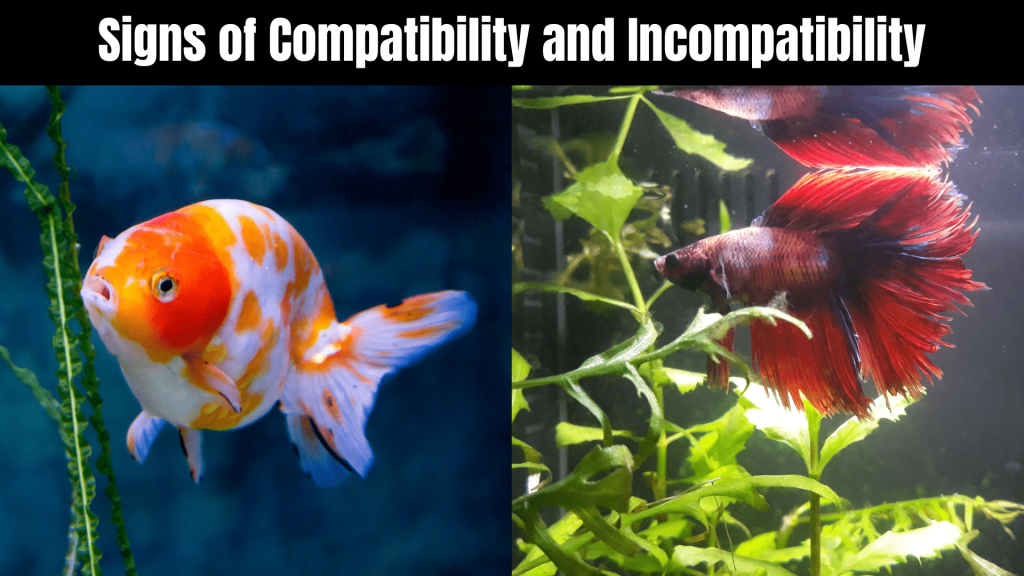
When attempting to house betta fish and goldfish together, it’s essential to observe their behavior closely to determine if they are compatible tank mates. Here are some signs of compatibility and incompatibility to look out for:
Friendly Interactions
Signs of compatibility include peaceful coexistence and harmonious interactions between the bettas and goldfish. In a well-matched community tank, you may observe the following friendly behaviors:
Peaceful Swimming
Betta fish and goldfish swim together comfortably without displaying signs of stress or aggression.
Schooling
Goldfish may form schools, especially if they are of the same variety. This behavior indicates a sense of security and contentment in the tank.
Shared Spaces
Both bettas and goldfish can occupy the same areas of the tank without territorial disputes. They may even explore the tank together and investigate new decorations.
Feeding Together
All fish actively feed during mealtime without aggressive behavior. Each fish should have an opportunity to eat without being chased away from the food.
Aggressive Behaviors
Incompatibility may be evident through aggressive behaviors exhibited by either betta fish or goldfish. These behaviors can lead to stress, injury, and even fatalities. Signs of aggression include:
Fin-Nipping
Betta fish may nip at the fins of goldfish, causing damage and stress. Conversely, goldfish may also nip at the flowing fins of bettas, leading to torn fins.
Chasing and Aggression
One fish relentlessly chasing another is a clear sign of aggression. This behavior is particularly concerning when it targets one specific individual.
Territorial Displays
Betta fish may flare their gill covers and extend their fins as a territorial display, especially towards other males or fish with similar appearances.
Stress and Health Indicators
Incompatible tank mates can lead to stressed and unhealthy fish. Signs of stress include:
Erratic Swimming
Fish swimming rapidly and in a panicked manner may indicate stress.
Loss of Appetite
A sudden decrease in appetite can be a sign of stress or illness.
Faded Colors
Bettas and goldfish may lose their vibrant colors when they are stressed or feeling unwell.
Hiding
Fish that spend excessive time hiding in corners or behind decorations may be trying to escape aggressive tank mates.
Injuries and Damage
Physical injuries, such as torn fins or wounds, are clear indicators of compatibility issues. If any fish show signs of injuries, it’s essential to act promptly to prevent further harm.
It’s important to understand that each fish has its unique personality, and compatibility may vary among individuals. While some bettas and goldfish can cohabitate peacefully, others may never be suitable tank mates. Careful observation is key to determining whether housing bettas and goldfish together is a viable option.
Tips for Maintaining a Peaceful Community Tank
Creating a peaceful community tank that houses both betta fish and goldfish requires consistent maintenance and careful attention to their specific needs. Here are some essential tips to help you maintain a harmonious environment.

Regular Water Testing and Maintenance
Consistently monitor the water quality in the tank by conducting regular water tests. Ammonia, nitrite, nitrate, and pH levels should be checked weekly to ensure they remain within appropriate ranges.
Perform partial water changes of about 20-25% every 1-2 weeks, or more frequently if necessary, to keep the water clean and free from harmful substances. Maintaining good water quality is vital for the health and well-being of all tank inhabitants.
Proper Feeding and Nutrition
Provide a balanced diet suitable for both bettas and goldfish. Bettas are carnivores and primarily eat small insects and larvae in their natural habitat. Pellet or flake foods formulated for bettas with high protein content are recommended.
Goldfish are omnivores and will eat both plant matter and small invertebrates. High-quality sinking pellets or flakes designed for goldfish should be offered, along with occasional treats like frozen or live foods.
Be mindful not to overfeed, as uneaten food can lead to water quality issues. Feed the fish in small portions, and only offer as much as they can consume within a few minutes.
Observing and Separating Aggressive Individuals
Pay close attention to the behavior of both bettas and goldfish. If any fish consistently displays aggressive behaviors or causes harm to others, it’s essential to separate them from the rest of the tank inhabitants.
Using a tank divider is an effective way to isolate aggressive individuals temporarily until a suitable long-term solution can be found. Providing each fish with its space will help reduce stress and potential conflicts.
Tank Enrichment and Stimuli
Keep the tank environment engaging and enriched to reduce boredom and stress in both bettas and goldfish. Add a variety of decorations, live plants, and hiding spots to create a visually stimulating environment.
Rotate decorations occasionally to provide novelty and keep the fish curious about their surroundings. Adding floating plants or tall structures can also help create a sense of security for both species.
Health Monitoring
Regularly inspect the fish for any signs of illness or injury. Early detection of health issues allows for timely intervention and treatment.
If any fish shows signs of stress, disease, or physical injuries, isolate them immediately for quarantine and treatment. This precaution can prevent the spread of diseases and further harm to other tank inhabitants.
Here are Some Frequently Asked Questions About Can Betta Fish Live With Goldfish?
Can betta fish live with other tropical fish?
It is possible to house betta fish with other non-aggressive tropical fish, but careful observation and appropriate tank setup are crucial.
Can goldfish survive in a small bowl?
Goldfish require a large tank with adequate filtration and oxygenation. They are not suitable for small bowls.
Can male bettas live together in the same tank?
Male bettas are highly territorial and tend to fight, so keeping them together is not recommended.
How often should I feed betta fish and goldfish?
Both bettas and goldfish should be fed 2-3 times a day, but be cautious not to overfeed.
Can bettas and goldfish recognize their owners?
While fish may not recognize their owners in the traditional sense, they can associate them with food and positive interactions.
Can I keep multiple goldfish in the same tank?
Yes, goldfish are social creatures and generally do well in groups. However, ensure that the tank is large enough to accommodate all the goldfish comfortably.
Conclusion
In conclusion, the question of whether betta fish can live with goldfish depends on various factors. While it is possible under specific conditions, it requires careful planning, observation, and consideration of both species’ needs. By creating a harmonious environment, fish enthusiasts can enjoy the beauty of bettas and goldfish coexisting peacefully.


